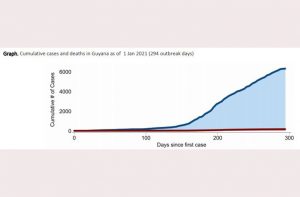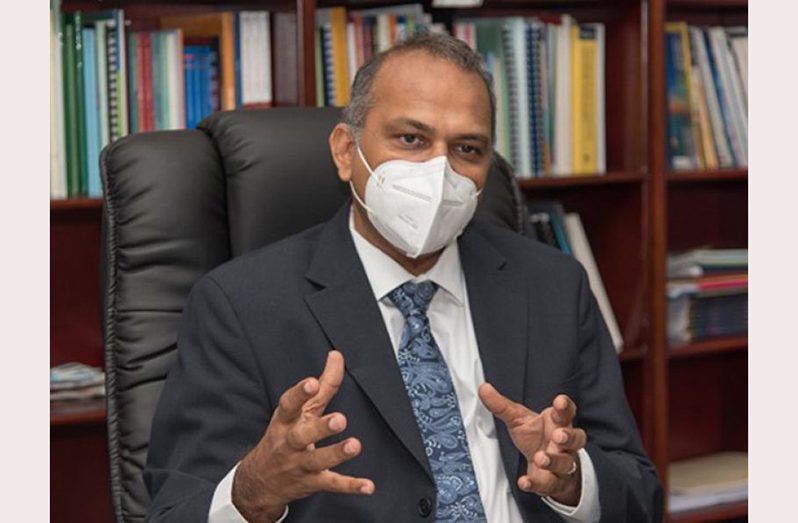– Health Minister says deeper analysis of pandemic will be done, eventually
IN the context of the COVID-19 pandemic, data collection and statistical analysis would help the health sector discern whether there have been “excess deaths” caused. But, limited available data and statistics impede an analysis of this, and of many more fields within the health sector.
Data and statistics are quantitative tools that are used to keep records and assist in studying and analysing occurrences and trends. They help to inform the decision-making process since such information provides a more credible and reliable mechanism of solving problems.

[ Graph created by the George Alleyne Chronic Disease Research Centre and the Public Health Group of The Faculty of Medical Sciences, Cave Hill Campus, The University of the West Indies]
The COVID-19 pandemic, however, has directed increasing focus on the burden of mortality that could be directly or indirectly related to the pandemic. Simply put, it begs the questions: Were there many more deaths than normally expected? And was this because of the novel coronavirus?
The Center for Disease Control and Prevention (CDC), a national public health institute in the United States, defines excess deaths as the difference between the deaths observed in a specific time period (such as one year) and the number of deaths that were expected for that same specific period. The “expected” deaths are calculated from the average number of deaths during the period over the past five years.
At the end of 2020, there were 164 deaths caused by or related to COVID-19 in Guyana. For weeks, the Guyana Chronicle has tried to gather statistics on the local mortality rates for, at least, the past five years. This would help with an analysis of whether there have been excess deaths. Accessing that information, if it was documented, has been a challenge.
“With reference to the stats [statistics] you requested, as you might have guessed, record keeping/retrieval over the last four to five years is proving to be extremely challenging,” one reliable source told this newspaper. Similar responses were garnered from various bodies.
In 2020, the Pan-American Health Organisation’s (PAHO)’s Non-Communicable Diseases (NCDs) progress monitor for Guyana stated that 4,400 deaths (or 68 per cent of all deaths) were caused by NCDs. This report was published in March 2020, which meant that this information was applicable to the year before. Performing basic mathematical calculations, this therefore meant that the total number of deaths would have been approximately 6,471.
In 2019, also, Guyana recorded 94 deaths due to road accidents. Sourcing other information on the numbers and causes of deaths has been difficult and often, whatever is accessible is outdated. Therefore, it is hard to compare and discern whether there have been excess deaths. Nevertheless, the Health Minister affirmed that once the health sector is able to control the pandemic better, the ministry would “go back and investigate whether there are excess deaths.”
“That’s something that we have to do… (we have) to compare deaths in the earlier part of the year with deaths in the latter part of the year,” Dr. Anthony said. Another issue which may become apparent once such an investigation is done is whether persons might have died from the coronavirus, but their deaths were misclassified since the person may not have been tested for COVID-19.
For context, research has shown that persons with pre-existing medical conditions (comorbidities), such as an NCD, are more vulnerable to the severe and life-threatening effects of COVID-19. And, over the past few months, as a precautionary measure, individuals who died are swabbed before a post-mortem examination is performed to discern whether they were infected with COVID-19. If they are, the virus may have exacerbated their condition and contributed to their death, more so, if they were affected by a comorbidity.
“In that case, you might see an increase (in the number of deaths) in other categories like heart diseases and other things like respiratory diseases or something, and then you would probably have to rethink whether or not this symptomology might have been COVID-19 and it went undetected,” Dr. Anthony explained. He, however, lamented that such an investigation demands time and resources to go through the death records to establish the level of excess deaths and perhaps even reclassify some of those deaths. According to a BBC report in November 2020, the total number of “excess” deaths in the United Kingdom since the start of the pandemic was 70,839. Just before Christmas Day, that number increased to 81, 300.



.jpg)









